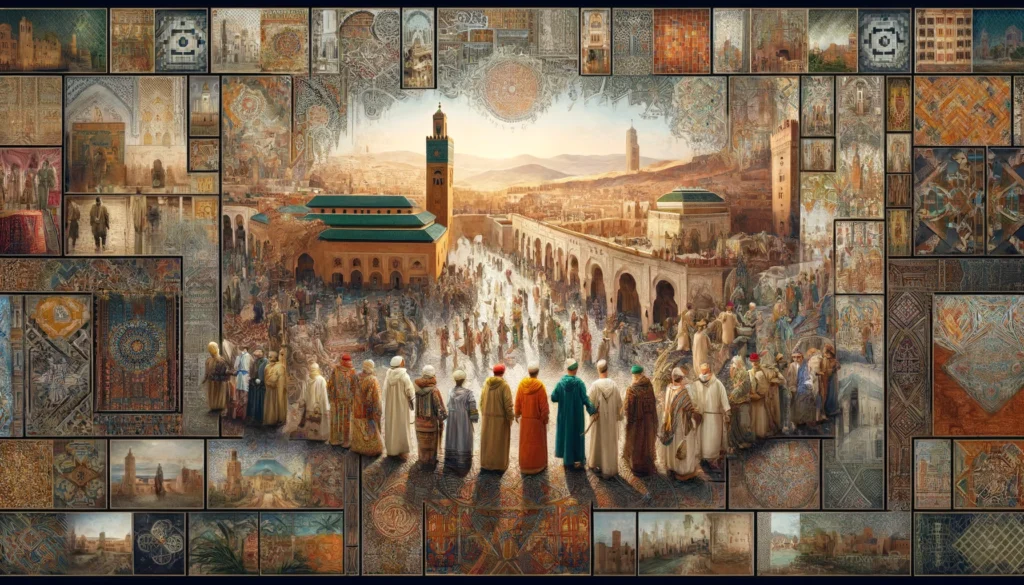Morocco’s rich tapestry of culture and history is vividly reflected in its traditional attire, with the kaftan and djellaba standing out as iconic symbols of its heritage. These garments are not merely pieces of clothing but are imbued with centuries of tradition, artistry, and social significance. This exploration into the historical and cultural roots of Moroccan attire offers a window into the soul of Morocco, revealing the depth and diversity of its identity.
Kaftan: The Regal Robe
Historical Origins
The kaftan, a long, flowing robe that has graced the annals of Moroccan history, traces its origins back to the ancient Middle Eastern civilizations. It was adopted into Moroccan culture during the Islamic expansion, becoming a staple of Moroccan fashion. Historically, kaftans were worn by royalty and nobility, adorned with luxurious fabrics and elaborate designs to signify status and wealth.
Cultural Significance
Beyond its beauty, the kaftan embodies the principles of modesty and dignity, central to Moroccan values. It’s worn by both men and women, though styles and materials may vary, reflecting the diversity of Morocco’s regions and cultural influences. The kaftan’s versatility and elegance have made it a cherished garment for special occasions, including weddings, festivals, and religious celebrations.
Djellaba: The Cloak of Comfort
Roots in Practicality and Piety
The djellaba, with its distinctive hood (called a ‘qob’), is designed for both practicality and piety. Originating from the Berber traditional wear, it is suited to the varied Moroccan climate, providing protection from the sun, wind, and sand. The djellaba’s simplicity and functionality reflect the Moroccan people’s connection to their environment and their adherence to Islamic principles of modesty.
A Symbol of Identity
Worn by men and women alike, the djellaba has transcended its humble beginnings to become a symbol of Moroccan identity and pride. The garment’s colors, fabrics, and patterns vary across regions, each telling a story of local customs, climates, and craftsmanship. Today, the djellaba remains a ubiquitous sight across Morocco, from the bustling souks of Marrakech to the tranquil villages of the Atlas Mountains.

Modern Evolution and Global Influence
From Traditional to Contemporary
While deeply rooted in tradition, Moroccan attire has evolved, embracing contemporary influences while retaining its cultural essence. Designers have reimagined the kaftan and djellaba, experimenting with new materials, cuts, and adornments, thus broadening their appeal to a global audience. These modern interpretations honor the past while reflecting the dynamic nature of Moroccan culture.
Moroccan Attire on the World Stage
The global fashion industry has taken notice of the unique allure of Moroccan attire, with international designers drawing inspiration from its rich textures, vibrant colors, and intricate embroidery. Moroccan kaftans and djellabas have graced runways and red carpets, celebrated for their elegance and cultural depth.
The kaftan and djellaba have maintained their relevance in modern Moroccan society by adapting to contemporary fashion trends while preserving their traditional essence. Designers have innovated these garments with new fabrics, colors, and embellishments, making them suitable for both everyday wear and special occasions. Their enduring presence is also rooted in their cultural significance, embodying Moroccan values of modesty, dignity, and identity, which resonate with Moroccans today.
Craftsmanship plays a crucial role in the creation of traditional Moroccan attire, with artisans employing centuries-old techniques to produce each garment. The kaftan and djellaba are often handmade, featuring intricate embroidery, beadwork, and fabric dyeing that reflect the skill and artistry of Moroccan craftsmen. This attention to detail and quality not only makes these garments unique but also celebrates Morocco’s rich heritage of textile art.
Yes, the global popularity of Moroccan attire can significantly influence perceptions of Moroccan culture, showcasing its rich artistic heritage and vibrant traditions to a worldwide audience. As international designers incorporate Moroccan elements into their collections and celebrities don Moroccan attire on global platforms, it fosters a greater appreciation and understanding of Moroccan culture. This visibility can lead to increased interest in Morocco’s history, art, and customs, promoting cultural exchange and understanding.
Moroccan attire, with its deep historical roots and rich cultural significance, continues to captivate and inspire. The kaftan and djellaba are not just garments but narrators of Morocco’s storied past, its vibrant present, and its promising future, weaving together threads of tradition and innovation.
